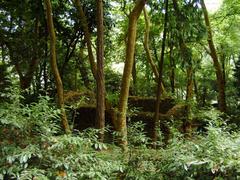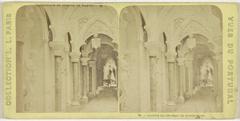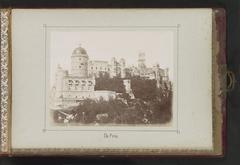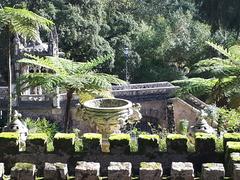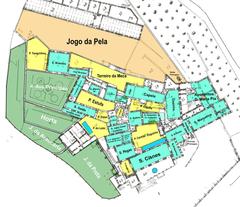
Anta do Senhor da Serra, Sintra, Portugal: Visiting Hours, Tickets, and Historical Significance
Date: 04/07/2025
Introduction
Nestled in the scenic Sintra-Cascais Natural Park, the Anta do Senhor da Serra—also known as the Anta da Pedra dos Mouros—is one of Portugal’s most significant prehistoric monuments. This guide explores its archaeological importance, practical visitor information such as opening hours and ticketing, accessibility, conservation challenges, and tips for an enriching and responsible visit. Whether you are an archaeology enthusiast, cultural traveler, or simply curious about Sintra’s ancient roots, this comprehensive resource will help you discover and appreciate this remarkable megalithic dolmen (Jardins Históricos; Wikipedia EN; Megalithic Portal).
Historical Background and Archaeological Significance
Prehistoric Context and Regional Setting
The Anta do Senhor da Serra is part of the Antas de Belas cluster in the Sintra region, alongside notable dolmens such as Anta da Estria and Anta do Monte Abraão. Situated at the foothills of the Serra da Carregueira and surrounded by fertile valleys and natural streams, the area was a focal point of Neolithic and early Chalcolithic activity between 4000 and 2500 BCE (Jardins Históricos). These megalithic tombs are integral to the broader Estremadura megalithic tradition, which is characterized by a diversity of burial types and a high density of prehistoric sites (Semanticscholar PDF).
Discovery and Early Research
First identified in 1856 by geologist Carlos Ribeiro, the Anta do Senhor da Serra became one of the earliest scientifically documented megalithic monuments in Portugal. Ribeiro’s systematic excavations and detailed descriptions in the late 19th century laid the foundation for Portuguese archaeological research into megalithic structures (Wikipedia PT). Later investigations by national heritage organizations confirmed and expanded on Ribeiro’s findings, further establishing the monument’s archaeological value.
Architectural Features and Construction Techniques
The monument consists of a polygonal burial chamber formed by massive upright limestone orthostats, with an entrance corridor that was originally covered by a tumulus. The chamber measures approximately 2–5 meters wide and up to 2.75 meters high (Wikipedia EN). Geological studies confirm the use of locally sourced limestone. Although the capstone is missing, the chamber’s construction demonstrates advanced knowledge of stoneworking and monument building among prehistoric communities.
Funerary Use and Material Culture
The Anta do Senhor da Serra was used for collective burials, a common practice in the region during the Neolithic and Chalcolithic periods. Finds from the site and similar dolmens include arrowheads, bone objects, and ceramics, reflecting ritual practices and the social importance of ancestor veneration (Wikipedia EN).
Cultural and Historical Significance
This monument, along with the other Antas de Belas, marks a pivotal chapter in Iberian prehistory, illustrating the technical skills, social complexity, and ritual traditions of ancient communities (Semanticscholar PDF). Folklore and local traditions, such as the dedication to “Nosso Senhor da Serra,” continue to underscore the site’s spiritual resonance. In 1910, the Anta do Senhor da Serra and its neighboring dolmens were classified as National Monuments, ensuring legal protection and conservation priority (Wikipedia DE).
Visiting Anta do Senhor da Serra: Practical Information
Location and Access
- Location: Near the village of Belas, Sintra municipality, about 15–20 km northwest of Lisbon and 10 km from Sintra’s historic center.
- GPS Coordinates: 38.8007° N, 9.2582° W.
How to Get There
- By Car: Take the A9 (CREL) motorway, exit at Belas, and follow signs for “Senhor da Serra.” Roadside parking is limited.
- By Public Transport: The nearest train station is Belas (Sintra-Lisbon suburban line), followed by a 2.5 km walk or short taxi ride to the site.
- On Foot/Bicycle: Popular with hikers and cyclists, the area features trails through the Sintra-Cascais Natural Park.
Visiting Hours and Ticket Information
- Visiting Hours: The site is accessible daily, year-round, typically from 9:00 AM to 6:00 PM. Some sources note open access 24/7 as the site is unfenced, but for safety and preservation, daytime visits are recommended.
- Tickets: Entry is free; no tickets or reservations are required for independent visits.
Facilities and Accessibility
- Accessibility: The monument is reached via an unpaved path and is not wheelchair accessible. Wear sturdy footwear and be prepared for uneven terrain.
- Facilities: No restrooms, cafés, or shops on-site; amenities are available in nearby Belas village.
- Signage: A bilingual panel (Portuguese and English) provides basic historical context.
Guided Tours and Educational Programs
- Guided tours are occasionally available through Sintra tourism offices or local operators (Sintra Explorers). Educational programs and interpretive materials are sometimes provided by the municipality or heritage organizations.
Best Time to Visit and Tips
- Best Season: Spring and autumn offer mild weather and fewer crowds.
- Photography: Early morning or late afternoon provides optimal lighting.
- What to Bring: Sturdy shoes, sun protection, water, and snacks.
Conservation Status and Modern Challenges
Despite National Monument status, the Anta do Senhor da Serra faces challenges such as urban encroachment, natural weathering, vandalism, and visitor impact (Wikipedia PT). The absence of formal infrastructure can accelerate soil erosion and stone degradation. Local authorities and heritage groups have implemented periodic monitoring, maintenance, and public awareness campaigns to aid preservation (Jardins Históricos).
Cultural Landscape and Nearby Attractions
The dolmen adds a prehistoric dimension to Sintra’s rich landscape, which is famed for its palaces, castles, and natural beauty (Sintra-Portugal.com). Nearby, visitors can explore:
- Anta da Estria and Anta do Monte Abraão: Additional megalithic sites in the Belas cluster.
- Sintra Historic Center: UNESCO World Heritage site with iconic landmarks like Pena Palace and the Moorish Castle.
- Sintra-Cascais Natural Park: Ideal for hiking, cycling, and nature photography.
Responsible Tourism and Preservation
Visitors play a crucial role in protecting the Anta do Senhor da Serra. Please:
- Stay on marked paths and avoid climbing on stones.
- Carry out all litter and use reusable containers.
- Support sustainable local businesses in Belas and Sintra.
- Respect the tranquility of the site and surrounding communities.
Frequently Asked Questions (FAQ)
Q: What are the visiting hours of Anta do Senhor da Serra?
A: The site is generally open daily from 9:00 AM to 6:00 PM, but some sources note open access year-round.
Q: Is there an entrance fee?
A: No, entry is free.
Q: Is the site accessible for people with mobility issues?
A: Due to uneven, unpaved paths, accessibility is limited.
Q: Are guided tours available?
A: Occasionally, through Sintra tourism offices or local operators.
Q: What is the best time to visit?
A: Spring and autumn for mild weather and optimal lighting.
Q: Are there facilities on-site?
A: No. Restrooms and shops are located in Belas.
Visuals and Media
For maps, photos, and interactive content, see:

Alt text: Anta do Senhor da Serra megalithic dolmen in Sintra, Portugal
Conservation and Community Engagement
The monument’s protection relies on legal status, community stewardship, and sustainable tourism. Initiatives include educational programs, environmental monitoring, and responsible visitor behavior. Supporting local conservation efforts and joining guided experiences contribute to site upkeep (Wikipedia DE).
Plan Your Visit
- Respect site boundaries and heritage guidelines.
- Minimize environmental impact.
- Download the Audiala app for guided tours and up-to-date visitor information.
- Explore Sintra’s broader heritage by visiting nearby historical and natural attractions.
Summary and Final Recommendations
The Anta do Senhor da Serra offers a tangible link to Portugal’s prehistoric past, showcasing the architectural ingenuity and ritual traditions of early Iberian communities. Its free access, scenic location, and proximity to other heritage sites make it an essential stop for anyone interested in archaeology or cultural history. By following responsible tourism practices and supporting local conservation initiatives, visitors can help safeguard this ancient monument for generations to come (Sintra Tourism Official Site; Wikipedia PT; Jardins Históricos).
References
- Jardins Históricos
- Wikipedia PT
- Wikipedia EN
- Wikipedia DE
- Megalithic Portal
- Sintra Explorers
- Sintra Tourism Official Site
For more travel inspiration and heritage guides, download the Audiala app and follow us on social media for updates on Sintra’s historical gems.



